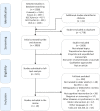Virtual reality applications based on instrumental activities of daily living (iADLs) for cognitive intervention in older adults: a systematic review
- PMID: 38110970
- PMCID: PMC10729470
- DOI: 10.1186/s12984-023-01292-8
Virtual reality applications based on instrumental activities of daily living (iADLs) for cognitive intervention in older adults: a systematic review
Abstract
Background: In recent years, the use of virtual reality (VR) as a complementary intervention in treating cognitive impairment has significantly increased. VR applications based on instrumental activities of daily living (iADL-VR) could offer a promising approach with greater ecological validity for intervention in groups with cognitive impairments. However, the effectiveness of this approach is still debated.
Objective: This systematic review aims to synthesize the effects of iADL-VR interventions to rehabilitate, train, or stimulate cognitive functions in healthy adults and people with mild cognitive impairment (MCI) and different types of dementia.
Methods: A systematic search was performed in the Scopus, PubMed, IEEE Xplore, Web of Science, and APA PsycNet databases until September 2022 and repeated in April 2023. The selected studies met the search terms, were peer-reviewed, included an iADL-VR intervention, and were written in English. Descriptive, qualitative studies, reviews, cognitive assessment, non-intervention studies, those unrelated to VR or iADL, those focused on motor aspects, and non-degenerative disorders were excluded. The PEDro scale was used to assess the methodological quality of the controlled studies. To present and synthesize the results, we organized the extracted data into three tables, including PEDro scores, participant characteristics, and study characteristics.
Results: Nineteen studies that met the inclusion and exclusion criteria were included. The total sample reached 590 participants, mostly women (72.67%). Approximately 30% were diagnosed with Alzheimer's disease or dementia, and 20% had mild cognitive impairment. Variables such as authors and year of publication, study design, type of intervention and VR applied, duration of the intervention, main findings, and conclusions were extracted. Regarding demographic characteristics, the sample size, age, sex, years of education, neurological diagnosis, dropouts, and the city and country where the intervention took place were recorded. Almost all studies showed improvements in some or all the outcomes after the intervention, generally greater in the iADL-VR group than in the control group.
Conclusion: iADL-VR interventions could be beneficial in improving the performance of cognitive functions in older adults and people with MCI and different types of dementia. The ecological component of these tasks makes them very suitable for transferring what has been learned to the real world. However, such transfer needs to be confirmed by further studies with larger and more homogeneous samples and longer follow-up periods. This review had no primary funding source and was registered with PROSPERO under registration ID: 375166.
Keywords: Cognitive functions; Cognitive rehabilitation; Mild cognitive impairment; Older adults; Virtual reality; iADL.
© 2023. The Author(s).
Conflict of interest statement
The authors declare that the research was conducted in the absence of any commercial or financial relationships that could be construed as a potential conflict of interest.
Similar articles
-
Occupational therapy for cognitive impairment in stroke patients.Cochrane Database Syst Rev. 2022 Mar 29;3(3):CD006430. doi: 10.1002/14651858.CD006430.pub3. Cochrane Database Syst Rev. 2022. PMID: 35349186 Free PMC article.
-
Virtual reality and cognitive rehabilitation for older adults with mild cognitive impairment: A systematic review.Ageing Res Rev. 2024 Jan;93:102146. doi: 10.1016/j.arr.2023.102146. Epub 2023 Nov 28. Ageing Res Rev. 2024. PMID: 38036103
-
Digital Endpoints for Assessing Instrumental Activities of Daily Living in Mild Cognitive Impairment: Systematic Review.J Med Internet Res. 2023 Jul 25;25:e45658. doi: 10.2196/45658. J Med Internet Res. 2023. PMID: 37490331 Free PMC article.
-
Efficacy of nicergoline in dementia and other age associated forms of cognitive impairment.Cochrane Database Syst Rev. 2001;2001(4):CD003159. doi: 10.1002/14651858.CD003159. Cochrane Database Syst Rev. 2001. PMID: 11687175 Free PMC article.
-
Ecological Effects of VR-Based Cognitive Training on ADL and IADL in MCI and AD patients: A Systematic Review and Meta-Analysis.Int J Environ Res Public Health. 2022 Nov 29;19(23):15875. doi: 10.3390/ijerph192315875. Int J Environ Res Public Health. 2022. PMID: 36497946 Free PMC article.
Cited by
-
A machine learning approach to evaluate the impact of virtual balance/cognitive training on fall risk in older women.Front Comput Neurosci. 2024 May 14;18:1390208. doi: 10.3389/fncom.2024.1390208. eCollection 2024. Front Comput Neurosci. 2024. PMID: 38808222 Free PMC article.
-
User Experience in Virtual Reality (VR) Applications for Elderly People with Cognitive Impairment and Dementia: A Scoping Review.Curr Alzheimer Res. 2024;21(11):765-778. doi: 10.2174/0115672050367594250206103806. Curr Alzheimer Res. 2024. PMID: 40033596
-
Role of visual function and performance of activities of daily living in cognitive function in patients with mild cognitive impairment: a cross-sectional study.Front Aging Neurosci. 2025 Feb 5;17:1505815. doi: 10.3389/fnagi.2025.1505815. eCollection 2025. Front Aging Neurosci. 2025. PMID: 39975602 Free PMC article.
-
The use of virtual reality as a perspective-taking manipulation to improve self-awareness in Alzheimer's disease.Front Aging Neurosci. 2024 Apr 25;16:1376413. doi: 10.3389/fnagi.2024.1376413. eCollection 2024. Front Aging Neurosci. 2024. PMID: 38725536 Free PMC article. Review.
-
Efficacy of Virtual Reality-Based Interventions on Cognitive Function in Patients With Neuropsychiatric Disorders: Systematic Review and Meta-Analysis of Randomized Controlled Trials.JMIR Serious Games. 2025 May 8;13:e67501. doi: 10.2196/67501. JMIR Serious Games. 2025. PMID: 40341171 Free PMC article. Review.
References
-
- Oort Q, Taphoorn MJB, Sikkes SAM, Uitdehaag BMJ, Reijneveld JC, Dirven L. Evaluation of the content coverage of questionnaires containing basic and instrumental activities of daily living (ADL) used in adult patients with brain tumors. J Neurooncol. 2019;143:1–13. doi: 10.1007/s11060-019-03136-9. - DOI - PMC - PubMed
Publication types
MeSH terms
LinkOut - more resources
Full Text Sources
Medical
Miscellaneous


